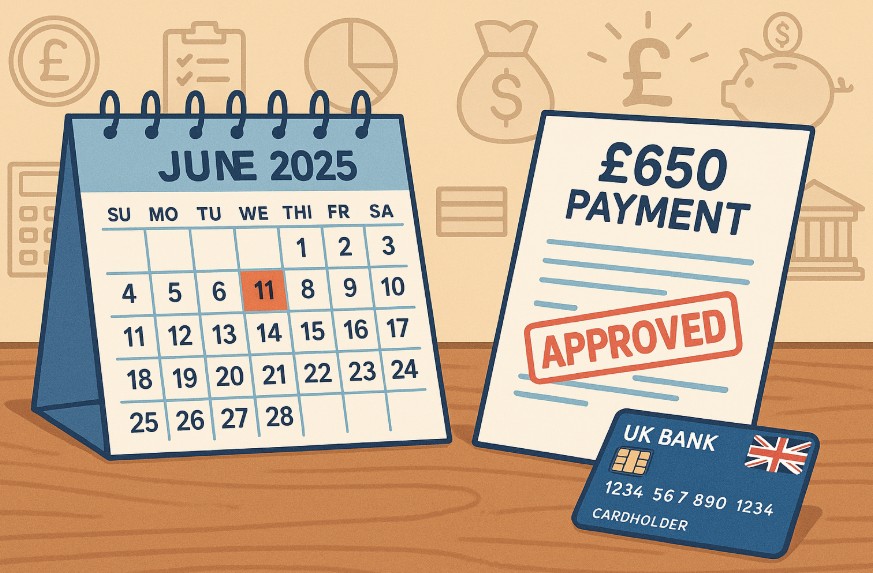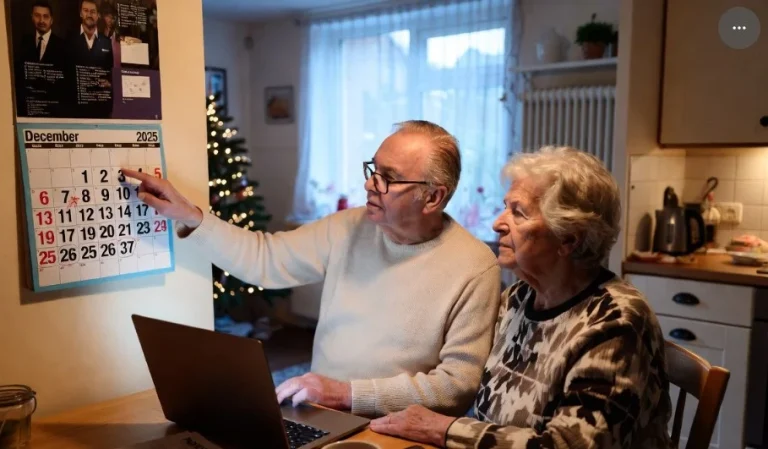The UK Government has introduced a £650 cost of living payment in 2025 to provide vital support to low-income households impacted by rising living costs.
With inflation continuing to affect essential expenses such as energy, rent, and food, this one-off payment aims to offer timely financial relief.
Administered by the Department for Work and Pensions, the payment is part of a broader effort to alleviate economic pressure for millions across the country without requiring any application process.
What is the £650 Cost of Living Payment in 2025?
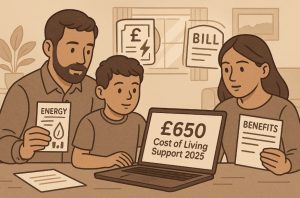
The £650 cost of living payment is a government initiative introduced in response to the ongoing financial pressures affecting millions of households across the UK.
With inflation impacting essential living expenses such as food, energy, and housing, the Department for Work and Pensions launched this payment as part of a wider economic support package.
This one-off payment is designed to provide financial relief for households on lower incomes. It is not taxable and does not affect existing benefit entitlements.
The payment helps address rising costs by offering additional support to those most in need, ensuring they can manage essential expenses without falling into further debt or hardship.
Over seven million households in the UK are expected to benefit from this scheme. The payment targets people already receiving means-tested benefits, reinforcing the government’s commitment to supporting vulnerable citizens during periods of economic instability.
Who is Eligible for the £650 Cost of Living Payment?
To be eligible for the £650 cost of living payment, individuals or households must have received at least one qualifying benefit between 1 March and 31 May 2025. These benefits include both Department for Work and Pensions payments and HMRC-administered tax credits.
The list of eligible benefits includes:
- Universal Credit
- Pension Credit
- Income-based Jobseeker’s Allowance (JSA)
- Income-related Employment and Support Allowance (ESA)
- Income Support
- Working Tax Credit
- Child Tax Credit (for those not receiving Universal Credit)
People receiving non-means-tested benefits, such as the State Pension, Disability Living Allowance, or Personal Independence Payment, are not eligible for this particular payment. However, the government has indicated that other support may be offered later in the year for those groups.
Eligibility is based solely on whether the recipient received one of the qualifying benefits during the assessment period. No application is required. The Department for Work and Pensions and HMRC use existing data to determine who qualifies, ensuring the process is automatic and efficient.
When Will the £650 Cost of Living Payment Be Paid?

The payment schedule has been clearly outlined by the Department for Work and Pensions to ensure transparency and public understanding. The first payments began disbursing on 15 June 2025. The aim is for all payments to be completed by 30 June 2025.
Recipients should expect to see the payment in their bank accounts with a description labeled as “DWP COLP” followed by their National Insurance number. This clear labeling helps recipients identify the source of the payment easily.
The government has set key milestones for distribution, as shown in the table below.
| Payment Date | Status |
| 15 June 2025 | First round of payments initiated |
| 20 June 2025 | More than 50% of payments successfully made |
| 30 June 2025 | Final phase of payment distribution |
Households are advised to check their bank accounts regularly during this period. If a payment has not been received by early July and eligibility criteria were met, recipients should contact the DWP for clarification.
How Will the £650 Payment Be Distributed?
How is Eligibility Verified?
The Department for Work and Pensions (DWP) and HM Revenue & Customs (HMRC) collaborate to identify eligible recipients using existing benefits records. This approach ensures the process is streamlined and avoids requiring individuals to reapply for a payment they already qualify for.
Eligibility is confirmed based on:
- Receipt of a qualifying benefit during the assessment period (1 March to 31 May 2025)
- Accurate and up-to-date records with either DWP or HMRC
- Bank account details linked to the active benefit claim
No additional paperwork is needed, and claimants are not expected to take any action to trigger payment.
What is the Method of Distribution?
The payment is made via direct bank transfer. Funds are sent to the same bank account that the claimant uses to receive their benefits. This ensures a quick, secure, and familiar method of disbursement for the recipient.
Each transaction appears on the recipient’s bank statement with the reference “DWP COLP” followed by the individual’s National Insurance Number. This helps claimants verify the source of the funds with ease.
What if Your Bank Details Have Changed?
For those who have recently changed bank accounts or switched their benefit payment method, it is important to inform the DWP or HMRC as soon as possible. Failure to update these details could delay the receipt of the £650 payment.
Claimants can update their information by:
- Logging into their Universal Credit online account
- Contacting the Jobcentre Plus helpline
- Using HMRC’s official online services (for Tax Credit recipients)
Is There Any Risk of Missing the Payment?
While the system is designed to be automatic, a small number of eligible households may encounter issues due to data discrepancies, recent benefit changes, or administrative errors.
If a qualifying household has not received the payment by 1 July 2025, they are advised to:
- Double-check that they met the eligibility criteria during the assessment window
- Review their bank transactions for the DWP COLP reference
- Contact the relevant department (DWP or HMRC) for further investigation
Scam alerts have been issued advising the public not to respond to emails, texts, or calls requesting personal or banking details. Official bodies will not request such information to issue the payment.
What Can Households Use the £650 Payment For?
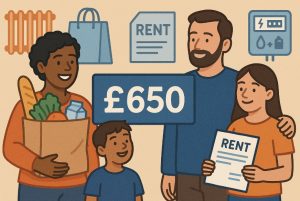
Is There Any Restriction on Use?
The £650 payment is unrestricted, meaning households can use it according to their individual financial priorities. Unlike specific grants tied to energy or rent, this support allows full discretion for the recipient.
This approach recognises that each household faces unique challenges and gives recipients the freedom to allocate funds where they are most needed.
Common Areas Where the Support is Spent
Although spending is not tracked by the government, local councils and third-party financial support organisations have reported patterns in how the funds are typically used:
- Housing Costs: Many households apply the funds to cover overdue rent or to make a full mortgage payment for the month. This helps reduce the risk of eviction or repossession.
- Utility Bills: A large portion of recipients use the payment to settle electricity, gas, and water bills. Given the energy price fluctuations in recent years, this is often a top priority.
- Grocery and Household Essentials: With inflation affecting food prices, families allocate funds to ensure they can purchase staple items, including fresh produce, cleaning products, and hygiene supplies.
- Debt Management: Households under financial strain often use this payment to reduce existing debts, such as credit cards, payday loans, or informal borrowing from friends and family.
- Emergency Funds: Some recipients choose to place part or all of the payment into savings as a precaution for unexpected future expenses.
Has the Payment Made a Measurable Impact?
Early indications from local authority data show that the £650 payment has helped ease the pressure on essential support services. For example:
- Food bank demand has seen a decline in several high-need regions
- Local councils report fewer requests for crisis loans and emergency grants
- Charitable organisations have observed a temporary reduction in hardship applications
The impact of this payment, although short-term in nature, is being tracked as part of the government’s broader cost of living response plan.
Why Flexibility is Important?
Unlike structured vouchers or benefits earmarked for specific services, this cash payment model offers households the flexibility to respond to their immediate priorities. Whether it’s clearing arrears or covering childcare costs, families are empowered to take control of their financial decisions without bureaucratic constraints.
What is the Payment Timeline for the £650 Cost of Living Support?
To ensure clarity and to manage public expectations, the Department for Work and Pensions provided an updated schedule for the distribution of payments. This timeline reflects the government’s aim to reach eligible households swiftly.
The following table outlines the official timeline for distribution:
| Date | Event |
| 15 June 2025 | Launch of first payment phase |
| 17–19 June | Continued payment processing to eligible claimants |
| 20 June 2025 | Over half of the payments completed |
| 25–28 June | Final checks and transfers initiated |
| 30 June 2025 | Completion of final payments to all recipients |
By maintaining a strict schedule, the government aims to ensure transparency and reduce the uncertainty surrounding disbursement. Anyone who qualifies should see the funds in their account by 30 June, and delays beyond this point are expected to be minimal.
How Does the £250 Cost of Living Credit Fit In?
In addition to the £650 support, the UK Government also announced a separate £250 cost of living credit, also scheduled for release in June 2025. While it is a distinct measure, some overlap in eligibility may occur, depending on the individual’s financial circumstances and the specific benefits they receive.
The £250 payment may be provided to individuals who are either:
- Ineligible for the £650 payment but still on lower incomes
- Facing hardship due to particular circumstances not covered by previous schemes
Although full details have yet to be confirmed by the government, early statements suggest the £250 payment will be available to those in income brackets just above the means-tested benefit threshold. More information is expected on the UK Government website closer to the rollout date.
Recipients may receive both the £650 and the £250 payments if they meet eligibility criteria for each. However, the government has stated that these payments will be issued and recorded separately to avoid confusion.
What are the Key Conditions to Remember About the £650 Payment?
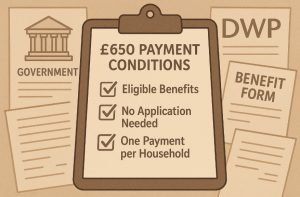
There are specific rules and conditions surrounding the disbursement of the £650 cost of living payment. These have been outlined to ensure fairness and clarity for all applicants.
- Only one payment is made per household. Joint claimants (such as couples claiming Universal Credit together) will not receive two separate payments.
- To be eligible, the claimant must have been receiving one of the qualifying benefits at any point during the eligibility window between 1 March and 31 May 2025.
- Payments are made automatically. There is no need to submit an application or fill out additional forms.
- The payment is tax-free and will not be considered as income when calculating entitlement for other benefits.
- The DWP handles all communications regarding eligibility, payment issues, or updates. Claimants are advised not to respond to messages requesting personal or bank information unless it comes from verified government sources.
In some cases, there may be discrepancies in records due to recent changes in claimant status. In such situations, it is recommended to contact the Department for Work and Pensions or visit the official GOV.UK website to report missing payments or seek assistance.
Conclusion
The £650 cost of living payment is a significant step by the UK Government to help those most affected by the current economic climate.
By supporting eligible households automatically and efficiently, the initiative seeks to ease immediate financial burdens.
Alongside additional measures like the £250 credit, this payment reflects a continued commitment to assist vulnerable communities.
Those meeting the criteria can expect to receive the funds by the end of June 2025, helping them manage essential costs more effectively.
Frequently Asked Questions
Can I receive the payment if I only get Child Benefit?
No. Child Benefit alone does not make you eligible. Only certain means-tested benefits qualify.
Will there be another cost of living payment later in 2025?
It is possible. The government has not ruled out additional support if economic pressures persist.
How do I know if I received the payment correctly?
The payment will appear on your bank statement with the label “DWP COLP” followed by your National Insurance Number.
What if my benefit claim started after May 2025?
You will not qualify for this particular payment. Eligibility is based strictly on the window between 1 March and 31 May 2025.
Do joint claimants receive two payments?
No. Only one payment is issued per household, regardless of the number of qualifying individuals.
Are tax credits still eligible for this support?
Yes. If you are not on Universal Credit but receive Working or Child Tax Credit, you may still be eligible.

